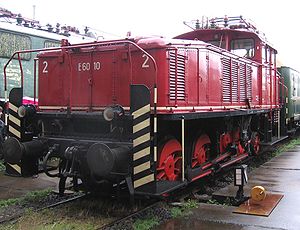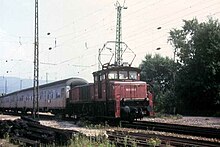DR series E 60
| DR series E 60 DB series 160 |
|
|---|---|
|
DR E 60 10 (built in 1932), parked in the DB Museum in Koblenz
|
|
| Numbering: | DR E 60 01-14 DB 160 001-014 |
| Number: | 14th |
| Manufacturer: | AEG , SSW |
| Year of construction (s): | 1927-1934 |
| Retirement: | 1983 |
| Axis formula : | 1'C |
| Gauge : | 1435 mm ( standard gauge ) |
| Length over buffers: | 11,100 mm |
| Height: | 3,850 mm |
| Fixed wheelbase: | 4,500 mm |
| Total wheelbase: | 6,600 mm |
| Service mass: | 72.5 t |
| Wheel set mass : | 19.3 t |
| Top speed: | 55 km / h |
| Hourly output : | 1074 kW / 1460 PS |
| Continuous output : | 830 kW |
| Starting tractive effort: | 150 kN |
| Performance indicator: | 14.8 kW / t |
| Driving wheel diameter: | 1250 mm |
| Impeller diameter front: | 850 mm |
| Power system : | 15 kV 16⅔ Hz |
| Number of traction motors: | 1 double engine |
| Drive: | Rod drive |
| Type of speed switch: | Electro-pneumatic contactor control with flow dividers |
The electric locomotives of the E 60 series of the Deutsche Reichsbahn (since 1968: DB series 160) were designed as electric shunting locomotives and were in regular service from 1927 to 1983.
history
In the 1920s, the lines around Munich were electrified by the Reichsbahn . Since the uneconomical shunting operation with steam locomotives was also to be replaced by electric locomotives , there was a need for electric shunting locomotives in the large train stations . For this reason, the Reichsbahn ordered two electric shunting locomotives in 1926. The order was tied to the condition that as many components as possible from the E 91 and E 52 series were used in the construction of the locomotives in order to make maintenance more economical.
The three rod-coupled drive axles with jackshafts and the drive with the double motor and the angled rods of the Winterthur type corresponded to half an E 91. A Bissel axle was added to distribute the load . The structure consisted of a very short, low front end, the driver's cab, on the roof of which the pantograph was mounted, and a long, low front end at the rear, which was beveled towards the end. The locomotives owed their nickname iron to this asymmetrical housing .
AEG delivered the E 60 01 and 02 in 1927, another five machines followed in 1928 and a third series of seven locomotives in 1934. The E 60 01 to 12 locomotives were electrically and mechanically equipped by AEG, while the electrical part of the E 60 13 and 14 came from SSW . The locomotives were stationed at the depots in Munich Hbf , Rosenheim and Garmisch . In the course of time, however, the E 60 was used at all major electrified railway stations in Bavaria, and from 1938 also in Austria. At the end of the war there were seven locomotives in Austria, but these were returned in 1945 and 1946.
When delivered, the locomotives had an HIIs2D pantograph with two widely spaced contact strips in order to be able to bridge separation points. From 1945 to 1948, the locomotives were fitted with SBS 10 pantographs with only one contact strip; from 1960 onwards, some locomotives were retrofitted with a double rocker. For use on branch lines, the locomotives initially had a bell on the cab roof. In 1958/59 the locomotives were rebuilt in the Munich-Freimann AW , the driver's cab got two windows on each side and an additional window on the front sides, shunting platforms were added to the front sides and the large cooling coils on the side were replaced by smaller ones. The power supply from the pantograph to the engine compartment was now off-center and had a curved shape.
German Federal Railroad
At the end of the 1950s, the locomotives were completely modernized. You got u. a. Shunting crossings at both ends of the locomotive, extensive modernization of the electrical equipment and additional cab windows on the side. In 1964 E 60 05 and 06 came to Heidelberg . In 1968 the E 60 were redesignated as the 160 series. At that time, were all fourteen locomotives in use and distributed to the depots Garmisch, Rosenheim, Freilassing , Heidelberg and Treuchtlingen .
End of use

In 1976, the Deutsche Bundesbahn deleted the 160 series from the maintenance inventory, in 1977 the first two locomotives were retired, in 1980 only three locomotives were in service: the 160 003 in Freilassing and the 160 009 and 012 in Heidelberg. On August 31, 1983, 160 012, the last locomotive of the class 160 was decommissioned due to a lack of spare parts after a broken rod (the train driver had pressed the direction switch while driving).
Museum locomotives
Three class 160 locomotives have been preserved in a museum:
- 160 009 in the Darmstadt-Kranichstein Railway Museum
- 160 010 as the official museum locomotive of Deutsche Bahn is stationed in the DB Museum Koblenz ; see fig. in the info box.
- 160 012 in the Auto and Technology Museum Sinsheim
literature
- Horst J. Obermayer: Paperback German electric locomotives . 7th edition. Franckh'sche Verlagshandlung, Stuttgart 1986, ISBN 3-440-03754-1 .
- Frank Lüdecke: The electric locomotives of the E 60 and E 63 series . 1st edition. Eisenbahn-Kurier, Freiburg 1979, ISBN 3-88255-201-8 .
Web links
- DB 160 010 1973 in Munich main station 1973 on the Joachim Schmidt Railway Foundation

